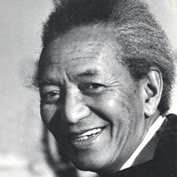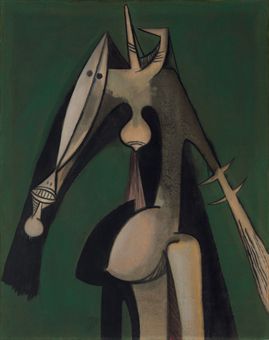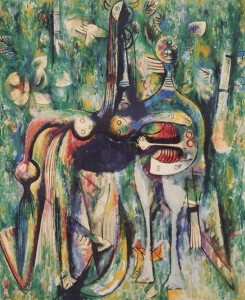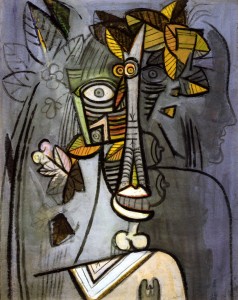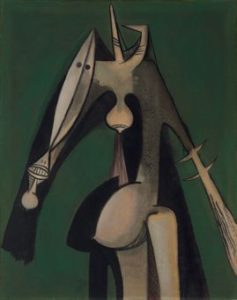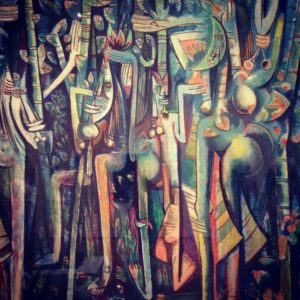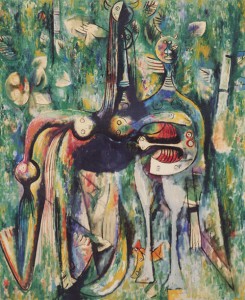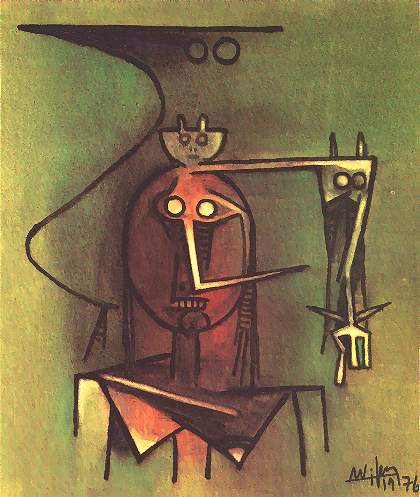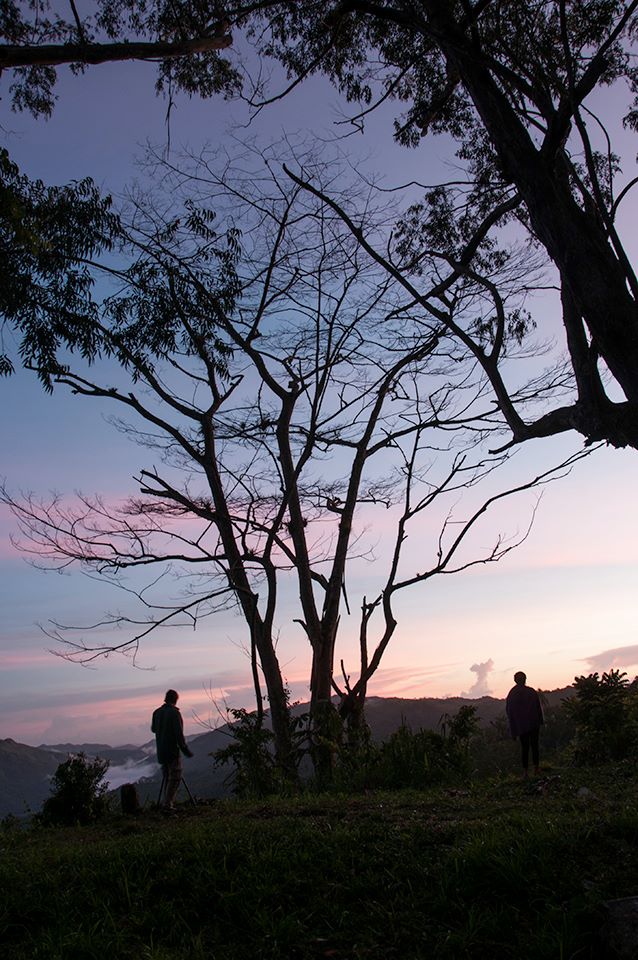WIFREDO LAM, PAINTER, SCULPTOR. (Born: Sagua La Grande).
Wifredo Óscar de la Concepción Lam y Castilla (Chinese: 林飛龍; pinyin: Lín Fēilóng; December 8, 1902 – September 11, 1982), better known as Wilfredo Lam, was a Cuban artist who sought to portray and revive the enduring Afro-Cuban spirit and culture. Inspired by and in contact with some of the most renowned artists of the 20th century, Lam melded his influences and created a unique style, which was ultimately characterized by the prominence of hybrid figures. Though he was predominantly a painter, he also worked with sculpture, ceramics and printmaking in his later life.
Early life.
Wifredo Lam was born and raised in Sagua La Grande, a village in the sugar farming province of Villa Clara, Cuba. He was of mixed-race ancestry: his father, Yam Lam, was a Chinese immigrant and his mother, the former Ana Serafina Castilla, was born to a Congolese former slave mother and a Cuban mulatto father. In Sagua La Grande, Lam was surrounded by many people of African descent; his family, like many others, practiced Catholicism alongside their African traditions. Through his godmother, Matonica Wilson, a Santería priestess locally celebrated as a healer and sorceress, he was exposed to rites of the African orishas. His contact with African celebrations and spiritual practices proved to be his largest artistic influence.
In 1916, Lam moved to Havana to study law, a path that his family had thrust upon him. Simultaneously, he also began studying tropical plants at the Botanical Gardens. From 1918 to 1923, Lam studied painting at the Escuela de Bellas Artes. However, Lam disliked both academic teaching and painting. He left for Madrid in the autumn of 1923 to further his art studies.
Career in Europe.
In 1923, Lam began studying in Madrid under Fernando Álvarez de Sotomayor y Zaragoza, the curator of the Museo del Prado and teacher of Salvador Dalí. In the mornings he would attend the studio of the reactionary painter, while he spent his evenings working alongside young, nonconformist painters. At the Prado, Lam discovered and was awed by the work of Hieronymus Bosch and Pieter Bruegel I. While his early paintings were in the modernist Spanish tradition, his work soon became more simplified and decorative. Though Lam’s dislike for academic conservatism persisted, his time in Spain marked his technical development in which he began to merge a primitive aesthetic and the traditions of Western composition. In 1929, he married Eva Piriz but both she and their young son died in 1931 of tuberculosis; it is likely that this personal tragedy contributed to the dark nature of his work.
During the 1930s Lam was exposed to a variety of influences. In his work, the influence of Surrealism was discernible, as well as that of Henri Matisse. Throughout Lam’s travels through the Spanish countryside, he developed empathy for the Spanish peasants, whose strife, in some ways, mirrored that of the former slaves he grew up around in Cuba. Therefore, at the outbreak of the Spanish Civil War, Lam sided with the Republicans where he used his talent to fashion Republican posters and propaganda. Drafted to defend Madrid, Lam was incapacitated during the fighting in late 1937 and was sent to Barcelona. There, he met Helena Holzer, a German researcher, and the Catalan artist known as Manolo Huguë. Manolo gave Lam the letter of introduction that sparked his friendship with Picasso, whose artwork had impressed and inspired Lam a year before when he saw an exhibition in Madrid.
In 1938, Lam moved to Paris. Picasso quickly became a big supporter of Lam, introducing him to many of the leading artists of the time, such as Fernand Léger, Henri Matisse, Georges Braque and Joan Miró. Picasso also introduced him to Pierre Loeb, a Parisian art dealer; Loeb gave Lam his first exhibition at the Galerie Pierre Loeb in 1939, which received an enthusiastic response from critics.[5] Picasso and Lam also exhibited their work together at the Perls Galleries in New York in the same year. Lam’s work went from showing the influence of Matisse seen in his still lifes, landscapes and simplified portraits to being influenced by Cubism. Mainly working with gouache, Lam began producing stylized figures that appear to be influenced by Picasso. Much of his work in 1938 possessed emotional intensity; the subject matter ranged from interacting couples to women in despair and showed a considerably stronger African influence, seen in the figures’ angular outlines and the synthesis of their bodies.
While Lam began simplifying his forms before he came into contact with Picasso’s work, it is apparent that Picasso had a significant impact on him. With regard to Picasso’s exhibition, Lam said that it was “not only a revelation, but… a shock.” Lam gained the approval of Picasso, whose encouragement has been said to have led Lam to search for his own interpretation of modernism.
With the outbreak of World War II and the Germans invading Paris, Lam left for Marseille in 1940. There, he rejoined many intellectuals, including the Surrealists, with whom he had been associated since he met André Breton in 1939. In Marseille, Lam and Breton collaborated on the publication of Breton’s poem Fata Morgana, which was illustrated by Lam. Though the drawings he created in Marseille between 1940 and 1941 are known as the Fata Morgana suite, only about three inspired the illustrations for the poem. In 1941, Breton, Lam and Claude Lévi-Strauss, accompanied by many others, left for Martinique only to be imprisoned. After forty days, Lam was released and allowed to leave for Cuba, which he reached in midsummer 1941.
Havana years.
Upon Lam’s return to Havana, he developed a new awareness of Afro-Cuban traditions. He noticed that the descendents of the slaves were still being oppressed and that the Afro-Cuban culture was degraded and made picturesque for the sake of tourism. He believed that Cuba was in danger of losing its African heritage and therefore sought to free them from cultural subjugation. In an interview with Max-Pol Fouchet, he said,
“I wanted with all my heart to paint the drama of my country, but by thoroughly expressing the negro spirit, the beauty of the plastic art of the blacks. In this way I could act as a Trojan horse that would spew forth hallucinating figures with the power to surprise, to disturb the dreams of the exploiters.”
Additionally, his time in Cuba marked a rapid evolution of his style. Drawing from his study of tropical plants and familiarity with Afro-Cuban culture, his paintings became characterized by the presence of a hybrid figure—part human, animal and vegetal elements. His style was also distinctive because of its fusion of Surrealist and Cubist approaches with imagery and symbols from Santería. In 1943, he began his best-known work, The Jungle. It reflected his mature style, depicting four figures with mask-like heads, half-emerging from dense tropical vegetation. Later that year, it was shown in an exhibition at the Pierre Matisse Gallery in New York where it created controversy. The painting depicted the tension between Modernism and the vibrancy and energy of African culture. The Jungle was ultimately purchased by the Museum of Modern Art N.Y. It is often compared to Picasso’s Guernica, which is hung in the Museo Reina Sofía in Madrid.
Lam continued to simplify and synthesize abstraction yet continued painting figurally; he also kept on developing the mythology and totemism that defined his style. In 1944, he married Helana Holzer, whom he divorced in 1950. In 1946, he and Breton spent four months in Haiti, enriching his already extensive understanding and knowledge of African divinity and magic rituals through observing Vodoun ceremonies. Although he later said that his contact with the African spirituality that he found throughout the Americas did not directly impact his formal style. African poetry, on the other hand, was said to have had a broadening effect on his paintings. In 1950 Wifredo Lam worked together with René Portocarrero and others in the village Santiago de Las Vegas, the group of painters worked on ceramic. In 1952, Lam settled in Paris after having divided his time between Cuba, New York and France.
Lam, who continued to sympathize with the common man, exhibited a series of paintings at Havana University in 1955, to demonstrate his support for the students’ protests against Batista’s dictatorship. Similarly, in 1965, 6 years after the revolution, Lam showed his loyalty to Castro and his goals of social and economic equality by painting El Tercer Mundo (The Third World) for the presidential palace. In 1960, Lam established a studio in Albissola Marina on Italy’s northwest coast and settled there with his wife Lou Laurin, a Swedish painter, and their three sons. In 1964, he was awarded the Guggenheim International Award and between 1966 and 1967 there were many retrospectives of his work throughout Europe. At the encouragement of Asger Jorn and after being intrigued by the local pottery making, Lam began to experiment with ceramics and had his first ceramic exhibition in 1975. He progressed to model sculptures and cast in metal in his twilight years, often depicting personages similar to those he had painted.
Wifredo Lam died on September 11, 1982 in Paris. Having had over one hundred personal exhibitions around the world, Lam had a well established reputation by the time of his death.
Legacy.
Lam, like many of the most renowned artists of the 20th century, combined radical modern styles with the “primitive” arts of the Americas. While Diego Rivera and Joaquín Torres García drew inspiration from Pre-Columbian art, Wifredo Lam was influenced by the Afro-Cubans of the time. Lam dramatically synthesized the Surrealist and Cubist strategies while incorporating the iconography and spirit of Afro-Cuban religion. For that reason, his work does not singularly belong to an art movement.
He held the belief that society focused too much on the individual and sought to show humanity as a whole in his artwork. He painted generic figures, creating the universal. To further his goal, he often painted mask-like faces. While Cuban culture and mythology permeated his work, it dealt with the nature of man and therefore was wholly relatable to non-Cubans.
The Jungle, which is considered Lam’s masterpiece, is exemplary of the artist’s mature style. The polymorphism, for which Lam is well known, juxtaposes aspects of humans, animals and plants, creating monstrous, hybrid creatures. The dense composition creates a claustrophobic feeling while the forms remain difficult to differentiate. The figures’ elongated limbs lack definition, while much emphasis is placed on their large feet, round buttocks, and African-inspired masked heads. Additionally, the iridescent quality of the forms enhances the painting’s tropical feeling.
The Jungle was not, however, intended to describe the primitivism of Cuba. Rather, Lam’s intention was to depict a spiritual state—that which is surely inspired by Santería; he sheds light on the absurdity that has become Afro-Cuban culture and more specifically on the way their traditions were cheapened for tourism. He sought to describe the reality of his people through the powerful work and gained acclaim and fame for doing so.
Art Works.
Deux personnages. 1938. Collection Conseil général de Martinique, France.
Mother and Child. 1939. Art Institute of Chicago, Chicago.
Anamu. 1942. Museum of Contemporary Art, Chicago.
Satan. 1942. Museum of Modern Art, New York.
The Jungle. 1943. The Museum of Modern Art, New York.
Untitled. 1943. Museum of Fine Arts, Boston
Homenaje a jicotea. ca. 1943. Lowe Art Museum, University of Miami.
Untitled. 1945. Galerie Lelong, Paris.
Le guerrier. 1947. Galerie Lelong, Paris.
Le Reve. 1947. Hirshhorn Museum and Sculpture Garden, Smithsonian Institution.
Exodo. 1948. Howard University Gallery of Art, Washington, D.C.
L’Espirit aveugle. 1948. Indianapolis Museum of Art.
Lisamona. 1950. Collection Steven M. Greenbaum, New Hampshire.
Les enfants sans âme. 1964. Museum of Modern Art, Brussels.
El Tercer Mundo. 1965–1966. Museo Nacional de Bellas Artes, Havana.
The Shadow of Days. 1970.
Agencies/Various/Wiki/InternetPhotos/youtube/thecubanhistory.com
THE CUBAN HISTORY, HOLLYWOOD.
WIFREDO LAM, PINTOR, ESCULTOR. (Nacido: Sagua La Grande) .
Wifredo Óscar de la Concepción Lam y Castilla (en chino: 林飛龍, pinyin: Lin Fei Long; 8 diciembre 1902 hasta 11 septiembre 1982), más conocido como Wilfredo Lam, fue un artista cubano que trató de presentar y revivir el afro duradera el espíritu y la cultura cubanas. Inspirado por y en contacto con algunos de los artistas más reconocidos del siglo 20, Lam se fundió sus influencias y creó un estilo único, que finalmente fue caracterizada por el protagonismo de figuras híbridas. A pesar de que era predominantemente un pintor, también trabajó con la escultura, la cerámica y el grabado en su vida posterior.
Vida temprana.
Wilfredo Lam nació y se crió en Sagua La Grande, un pueblo en el cultivo de azúcar en la provincia de Villa Clara, Cuba. Era de ascendencia mestiza: su padre, Yam Lam, era un inmigrante chino y su madre, la ex Ana Serafina Castilla, nació de una madre esclava ex congoleño y un padre mulato cubano. En Sagua La Grande, Lam fue rodeado por muchas personas de ascendencia africana; su familia, como muchos otros, se practica el catolicismo junto a sus tradiciones africanas. A través de su madrina, Matonica Wilson, una sacerdotisa Santería celebrado localmente como sanador y hechicera, estaba expuesto a los ritos de los orishas africanos. Su contacto con celebraciones africanas y las prácticas espirituales resultó ser su más grande influencia artística.
En 1916, Lam se trasladó a La Habana para estudiar derecho, un camino que su familia le había puesto sobre él. Al mismo tiempo, también comenzó a estudiar las plantas tropicales en el Jardín Botánico. De 1918 a 1923, Lam estudió pintura en la Escuela de Bellas Artes. Sin embargo, Lam disgustaba tanto en la enseñanza académica y la pintura. Se fue a Madrid en el otoño de 1923 para continuar sus estudios de arte.
Carrera en Europa.
En 1923, Lam comenzó a estudiar en Madrid bajo Fernando Álvarez de Sotomayor, el curador del Museo del Prado y el maestro de Salvador Dalí. Por las mañanas iba a asistir al taller del pintor reaccionaria, mientras se pasaba las tardes trabajando junto a jóvenes pintores, no conformistas. En el Prado, Lam descubrió y fue impresionado por la obra de Hieronymus Bosch y Pieter Bruegel I. Si bien sus primeros cuadros estaban en la tradición modernista español, su trabajo pronto se hizo más simple y decorativa. A pesar de la aversión de Lam como el conservadurismo académico persistió, a su vez en España marcó su desarrollo técnico en el que empezó a combinar una estética primitiva y las tradiciones de la composición occidental. En 1929, se casó con Eva Piriz, pero tanto ella como su hijo murió en 1931 de tuberculosis; es probable que esta tragedia personal contribuyó a la naturaleza oscura de su obra.
Durante la década de 1930 Lam fue expuesto a una variedad de influencias. En su obra, la influencia del surrealismo era perceptible, así como la de Henri Matisse. A lo largo de los viajes de Lam por el campo español, desarrolló empatía por los campesinos españoles, cuyas luchas, de alguna manera, reflejaba la de los antiguos esclavos que creció en torno a Cuba. Por lo tanto, en el estallido de la Guerra Civil española, Lam puso del lado de los republicanos en la que utilizó su talento para la moda de los carteles republicanos y propaganda. Elaborado para defender Madrid, Lam fue incapacitado durante los combates a finales de 1937 y fue enviado a Barcelona. Allí, conoció a Helena Holzer, un investigador alemán, y el artista catalán Manolo Hugué conocido como. Manolo dio Lam la carta de presentación que desencadenó su amistad con Picasso, cuya obra había impresionado e inspirado Lam un año antes, cuando vio una exposición en Madrid.
En 1938, Lam se trasladó a París. Picasso se convirtió rápidamente en un gran defensor de Lam, presentándole a muchos de los principales artistas de la época, como Fernand Léger, Henri Matisse, Georges Braque y Joan Miró. Picasso también le presentó a Pierre Loeb, un comerciante de arte parisina; Loeb dio Lam su primera exposición en la Galerie Pierre Loeb en 1939, que recibió una respuesta entusiasta por parte de los críticos. [5] Picasso y Lam también exhibió su trabajo juntos en las galerías de Perls en Nueva York en el mismo año. la obra de Lam pasó de mostrar la influencia de Matisse visto en sus naturalezas muertas, paisajes y retratos simplificados para ser influenciado por el cubismo. Principalmente se trabaja con aguada, Lam comenzó a producir figuras estilizadas que parecen estar influenciado por Picasso. Gran parte de su trabajo en 1938 poseían intensidad emocional; la materia varió de interactuar parejas a las mujeres en la desesperación y mostró una influencia africana considerablemente más fuerte, se ve en los contornos angulares de las figuras y la síntesis de sus cuerpos.
Mientras Lam comenzó la simplificación de sus formas antes de que él entró en contacto con la obra de Picasso, es evidente que Picasso tuvo un impacto significativo sobre él. Con respecto a la exposición de Picasso, Lam dijo que era “no sólo es una revelación, sino un choque ….” Lam ganó la aprobación de Picasso, cuyo aliento se ha dicho haber llevado Lam en busca de su propia interpretación de la modernidad.
Con el estallido de la Segunda Guerra Mundial y los alemanes invaden París, Lam fue a Marsella en 1940. Allí, se reunió con muchos intelectuales, entre ellos los surrealistas, con el que había sido asociados desde que conoció a André Breton en 1939. En Marsella, Lam y Bretón colaboraron en la publicación del poema de Bretón Fata Morgana, que fue ilustrado por Lam. Aunque los dibujos que creó en Marsella entre 1940 y 1941 se conocen como la suite de Fata Morgana, sólo el tres por inspiró las ilustraciones para el poema. En 1941, Breton, Lam y Claude Lévi-Strauss, acompañado de muchos otros, fueron a Martinica sólo para ser encarcelado. Después de cuarenta días, Lam fue liberado y le permitió salir de Cuba, que alcanzó a mediados del verano de 1941.
La Habana años.
Sobre la vuelta de Lam de La Habana, desarrolló una nueva conciencia de las tradiciones afrocubanas. Se dio cuenta de que los descendientes de los esclavos seguían siendo oprimidos y que se degrada la cultura afrocubana y pintoresca hizo por el bien del turismo. Se cree que Cuba estaba en peligro de perder su herencia africana y por lo tanto trató de liberarlos de sometimiento cultural. En una entrevista con Max-Pol Fouchet, dijo,
“Yo quería con todo mi corazón para pintar el drama de mi país, pero expresando a fondo el espíritu negro, la belleza del arte plástico de los negros. De esta manera podría actuar como un caballo de Troya que brotase alucinando figuras con el poder de sorprender, molestar a los sueños de los explotadores “.
Además, su tiempo en Cuba marcó una rápida evolución de su estilo. A partir de su estudio de plantas tropicales y familiaridad con la cultura afrocubana, sus pinturas se hicieron caracterizan por la presencia de un híbrido de elementos de la figura partes humanas, animales y vegetales. Su estilo también era distintivo debido a su fusión de surrealista y cubista enfoques con imágenes y símbolos de la Santería. En 1943, comenzó su obra más conocida, La Selva. Se refleja su estilo maduro, que representa cuatro figuras con cabezas como máscaras, media que emerge de una densa vegetación tropical. Más tarde ese mismo año, se muestra en una exposición en la galería Pierre Matisse de Nueva York, donde se ha creado controversia. La pintura representa la tensión entre el Modernismo y la vitalidad y la energía de la cultura africana. La selva fue finalmente comprado por el Museo de Arte Moderno N. Y. A menudo se compara con el Guernica de Picasso, que se cuelga en el Museo Reina Sofía de Madrid.
Lam continuó simplificar y sintetizar la abstracción sin embargo, continuó pintando figuralmente; también mantuvo en el desarrollo de la mitología y el totemismo que define su estilo. En 1944, se casó con Helana Holzer, de quien se divorció en 1950. En 1946, él y Breton pasó cuatro meses en Haití, enriqueciendo su ya extensa comprensión y conocimiento de la divinidad africana y rituales de magia a través de la observación de ceremonias Voodoun. A pesar de que más tarde dijo que su contacto con la espiritualidad africana que había encontrado en el continente americano no impactó directamente a su estilo formal. poesía africana, por el contrario, se dice que han tenido un efecto en la ampliación de sus pinturas. En 1950 Wifredo Lam trabajó junto con René Portocarrero y otros en el pueblo de Santiago de Las Vegas, el grupo de pintores trabajó en cerámica. En 1952, Lam se instaló en París, después de haber dividido su tiempo entre Cuba, Nueva York y Francia.
Lam, que continuó a simpatizar con el hombre común, exhibió una serie de pinturas en la Universidad de La Habana en 1955, para demostrar su apoyo a las protestas de los estudiantes contra la dictadura de Batista. Del mismo modo, en 1965, 6 años después de la revolución, Lam mostró su lealtad a Castro y sus objetivos de igualdad social y económica por la pintura de El Tercer Mundo (El Tercer Mundo) para el palacio presidencial. En 1960, Lam estableció un estudio en Albissola Marina en la costa noroeste de Italia y se estableció allí con su esposa Lou Laurin, un pintor sueco, y sus tres hijos. En 1964, fue galardonado con el Premio Internacional Guggenheim y entre 1966 y 1967 había muchas retrospectivas de su obra en toda Europa. Con el aliento de Asger Jorn y después de ser intrigado por la toma de cerámica local, Lam comenzó a experimentar con la cerámica y tuvo su primera exposición de cerámica en 1975. Progresó para modelar esculturas y fundido en el metal en sus últimos años, a menudo representando personajes similares a los que había pintado.
Wifredo Lam murió el 11 de septiembre de 1982 en París. Después de haber tenido más de un centenar de exposiciones personales en todo el mundo, Lam tenía una reputación bien establecida en el momento de su muerte.
Legado.
Lam, al igual que muchos de los artistas más reconocidos del siglo 20, combina estilos modernos radicales con las artes “primitivas” de las Américas. Mientras que Diego Rivera y Joaquín Torres García se inspiró en el arte precolombino, Wifredo Lam fue influenciado por los afrocubanos de la época. Lam sintetiza de forma espectacular las estrategias surrealistas y cubistas al tiempo que incorpora la iconografía y el espíritu de la religión afrocubana. Por esa razón, su obra no pertenece singularmente a un movimiento de arte.
Él tenía la creencia de que la sociedad se centró demasiado en el individuo y trató de mostrar a la humanidad en su conjunto en su obra. Pintó figuras genéricas, creando lo universal. Para avanzar en su objetivo, a menudo pintado caras como máscaras. Mientras que la cultura y la mitología cubana impregnaron su obra, que se ocupó de la naturaleza del hombre y, por tanto, era totalmente relacionables con los no cubanos.
La selva, que se considera la obra maestra de Lam, es un ejemplo de estilo de madurez del artista. El polimorfismo, para los que Lam es bien conocida, yuxtapone los aspectos de seres humanos, animales y plantas, creando híbridos, criaturas monstruosas. La composición densa crea una sensación de claustrofobia mientras que las formas siguen siendo difíciles de diferenciar. extremidades alargadas de las figuras carecen de definición, mientras que gran parte se hace hincapié en sus grandes pies, las nalgas redondas, y la inspiración africana-cabezas enmascarados. Además, la calidad iridiscente de las formas mejora la sensación tropical de la pintura.
La selva no fue, sin embargo, pretende describir el primitivismo de Cuba. Por el contrario, la intención de Lam era para representar un estado espiritual que lo que sin duda se inspira en la santería; que arroja luz sobre el absurdo de que se ha convertido en la cultura afrocubana y más concretamente en la forma en que sus tradiciones se abarataron para el turismo. Se trata de describir la realidad de su pueblo a través del trabajo de gran alcance y consiguió el reconocimiento y la fama para hacerlo.
Obras de arte.
personnages deux. 1938. Colección Consejo General de Martinica, Francia.
Madre e hijo. 1939. Instituto de Arte de Chicago, Chicago.
Anamu. 1942. Museo de Arte Contemporáneo de Chicago.
Satán. 1942. Museo de Arte Moderno, Nueva York.
La jungla. 1943. El Museo de Arte Moderno, Nueva York.
Intitulado. 1943. Museo de Bellas Artes de Boston
Homenaje a jicotea. California. 1943. Lowe Art Museum, Universidad de Miami.
Intitulado. 1945. Galerie Lelong, París.
Le Guerrier. 1947. Galerie Lelong, París.
Le Reve. 1947. Museo Hirshhorn y Jardín de Esculturas, Smithsonian Institution.
Exodo. 1948. Howard University Gallery of Art, Washington, DC
aveugle L’Espirit. 1948. Indianapolis Museum of Art.
Lisamona. 1950. Colección Steven M. Greenbaum, Nueva Hampshire.
Les enfants sans âme. 1964. Museo de Arte Moderno, Bruselas.
El Tercer Mundo. 1965-1966. Museo Nacional de Bellas Artes, La Habana.
La sombra de los Días. 1970.
Agencies/Various/Wiki/InternetPhotos/youtube/thecubanhistory.com
THE CUBAN HISTORY, HOLLYWOOD.



 * WIFREDO LAM, Painter, Sculptor. (Born: Sagua La Grande). VIDEO. + WIFREDO LAM, Pintor, Escultor. (Nacido en Sagua la Grande). VIDEO.
* WIFREDO LAM, Painter, Sculptor. (Born: Sagua La Grande). VIDEO. + WIFREDO LAM, Pintor, Escultor. (Nacido en Sagua la Grande). VIDEO.